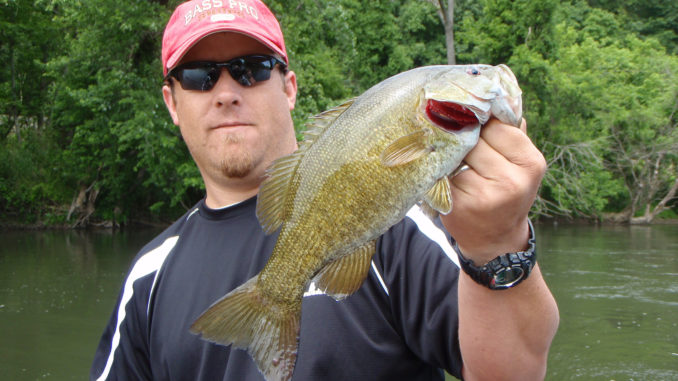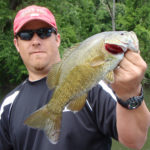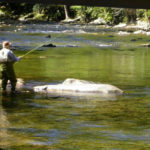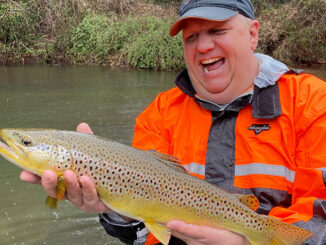
Tuckaseegee is easily accessed, great fishery
A multifaceted stream, the Tuckasegee River begins at the junction of Panthertown and Greenland creeks in southeastern Jackson County and flows northwest through Jackson into Swain County, where it eventually flows into Fontana Reservoir.
Between those two points are four diverse fisheries. The headwaters in Panthertown Valley is brook trout territory, regulated as catch-and-release waters. Below the headwaters to Tanasee Lake, the Tuckasegee has fair to good populations of wild brown and rainbow trout. Tanasee Lake is the first in a close series of three impoundments, followed by Bear Creek Lake and Cedar Cliff Lake. The smallest of the three lakes, Tanasee, has a small population of trout — Tanasee Creek offers much better trout fishing. Bear Creek and Cedar Cliff are excellent smallmouth and trout fisheries, and both lakes have public access ramps. Below Cedar Cliff, the Tuckasegee is joined by the West Fork.
This part of the river is hatchery-supported waters, but it often yields a good number of large brown and rainbow trout, some of them obviously wild. The section at the East Laport picnic and recreation area on NC 107 above Cullowhee once produced a state-record, 15-pound brown trout that stayed in the record books for several years. Caney Fork joins the river there, and it is usually a prime spot for trout fishing.
The most popular section begins at a bridge on NC 107 below Western Carolina University at the junction of Old Cullowhee Road. From there to Dillsboro, the stream is regulated as delayed-harvest waters from Oct. 1 until the first Saturday in June. The stream is heavily stocked in October and November and again in March, offering excellent catch-and-release fishing, even during the winter. From the first Saturday in June through September, the stream is regulated as hatchery-supported waters.
Guides use the delayed-harvest section as a place to teach beginning fly fishers. Catching a trout or two on a first outing is fairly common. Although the stocked trout have been raised entirely on trout pellets, it doesn’t take them long to adapt to their surroundings. They start eating insects after a few days.
Most of the fish stocked in the 5.5-mile section are at least 10 inches, but the N.C. Wildlife Resources Commission also stocks a few large brood fish that run up to 24 inches and weigh up to four pounds.
Even after bait fishers have had their time catching quick limits on the first day of the hatchery-supported season, fly fishers still can catch fish throughout the summer. Biologists estimate that half of the stocked fish are caught the first week of hatchery-supported rules, thinning out the trout and leaving more habitat and food for the survivors.
The Tuckasegee has good caddis hatches in the spring and consistent blue-winged olive hatches. During spawning seasons, egg patterns work well. Woolly Boogers, San Juan Worms, girdlebugs and nymph patterns with rubber legs are effective year-round. Fish streamers in large, deep pools.
A dam and power plant at Dillsboro were dismantled earlier this year, providing 32 miles of uninterrupted water flow. The river had been dammed at this point since 1913, and the dam’s removal has created a much more diverse fishery. A small dam still exists in Cullowhee adjacent to Western Carolina University. With the Dillsboro Dam gone, most of the river is wadable from the junction of the East and West forks to Dillsboro, even during periods of power generation. When you reach the big waters below Dillsboro, the river is usually too deep for wading.
Below Dillsboro and continuing to Bryson City, the fishery changes to a mix of brown, rainbow, and smallmouth bass, a section that bass fishers call “premier smallmouth territory.”
Most bass fishers use either a shallow-running Rebel or Rapala crawfish imitation, the bigger the better. Large spinners such as a yellow coach dog Rooster Tail also work well.
The big waters can be fished from a jonboat, driftboat, canoe, raft or belly-tube. Public access areas to the lower section are at Dillsboro Barkers Creek at Tuckasegee Outfitters on US 441/74, and a TVA public access at Ela where the Oconaluftee River joins the Tuckasegee.
The lower section also has a fair population of big bream, and from Ela to Bryson City, walleye often can be caught, especially during spawning time.
The Tuckasegee is one of the more accessible streams in the mountains, and it offers good fishing to boot.







Be the first to comment